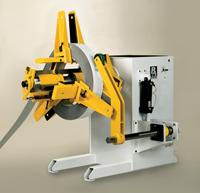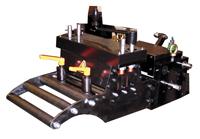- FMA
- The Fabricator
- FABTECH
- Canadian Metalworking
Categories
- Additive Manufacturing
- Aluminum Welding
- Arc Welding
- Assembly and Joining
- Automation and Robotics
- Bending and Forming
- Consumables
- Cutting and Weld Prep
- Electric Vehicles
- En Español
- Finishing
- Hydroforming
- Laser Cutting
- Laser Welding
- Machining
- Manufacturing Software
- Materials Handling
- Metals/Materials
- Oxyfuel Cutting
- Plasma Cutting
- Power Tools
- Punching and Other Holemaking
- Roll Forming
- Safety
- Sawing
- Shearing
- Shop Management
- Testing and Measuring
- Tube and Pipe Fabrication
- Tube and Pipe Production
- Waterjet Cutting
Industry Directory
Webcasts
Podcasts
FAB 40
Advertise
Subscribe
Account Login
Search
Spec the correct feed line
- By P/A Industries
- August 8, 2007
- Article
- Bending and Forming
Many factors are taken into consideration when ordering feed lines. To show how to spec this equipment could fill up this magazine, but this article is intended to show what information to supply to get the best possible results.
Ordering the Straightener
The straightener is the most specific piece of the line. Thickness, width, material type, and yield strength are the most important factors for sizing a straightener, not only for the material opening, but also for the drive sizing. Not only is it important to specify maximum and minimum width and thickness, but also the thickness at the max width, and the width at the maximum thickness. You can take advantage of less expensive equipment if you run only thicker material at narrow widths, although be careful not to use a cross section, as it takes eight times as much power to straighten something twice as thick. Yield strength and material type are also important when ordering the straightener. Material with a high yield strength must be bent more to reach the yield point; this requires more force placed on the rolls of the straightener and more power to move material through the straightener.
Ordering the Feeder
In addition to all the information from the straightener, feed length, strokes per minute (SPM), and feed window are important for making sure the feed is appropriately sized and will meet production requirements. The feed window is defined as the duration (in degrees) of the press revaluation that is available for feeding; this is when the upper half of the dieset is clear of the material and the lower half of the dieset. The larger the feed window, the more time the feeder has to make its move, and therefore the press can run at a faster speed. It is also important to determine if pilots are used in the tool. Surface finish is also important to make sure the configuration will not damage or mark the material.
Ordering the Stock Reel
The coil weight is the most important factor in ordering the reel, but other factors come into play. One must consider how they load the material. How does the material feed into the die, vertical or horizontal? Does the material come on a spool with a fixed ID, or is it loose and therefore need an adjustable mandrel? What is the range of coil ID and OD? Thickness is also important to determine the need for a hold-down arm, if a peeler is required, and if a pallet decoiler may be used.
General Considerations
A line must conform to the space constraints and press setup. One must specify feed direction. Looking at the front of the press, does material move left to right or right to left? Also provide the available space. Equipment providers have different solutions to fit the allotted space. If you are unsure, contact the company or their local representative. It will cost nothing; their input is very valuable.
About the Author
Related Companies
subscribe now

The Fabricator is North America's leading magazine for the metal forming and fabricating industry. The magazine delivers the news, technical articles, and case histories that enable fabricators to do their jobs more efficiently. The Fabricator has served the industry since 1970.
start your free subscription- Stay connected from anywhere

Easily access valuable industry resources now with full access to the digital edition of The Fabricator.

Easily access valuable industry resources now with full access to the digital edition of The Welder.

Easily access valuable industry resources now with full access to the digital edition of The Tube and Pipe Journal.
- Podcasting
- Podcast:
- The Fabricator Podcast
- Published:
- 04/16/2024
- Running Time:
- 63:29
In this episode of The Fabricator Podcast, Caleb Chamberlain, co-founder and CEO of OSH Cut, discusses his company’s...
- Industry Events
16th Annual Safety Conference
- April 30 - May 1, 2024
- Elgin,
Pipe and Tube Conference
- May 21 - 22, 2024
- Omaha, NE
World-Class Roll Forming Workshop
- June 5 - 6, 2024
- Louisville, KY
Advanced Laser Application Workshop
- June 25 - 27, 2024
- Novi, MI

































